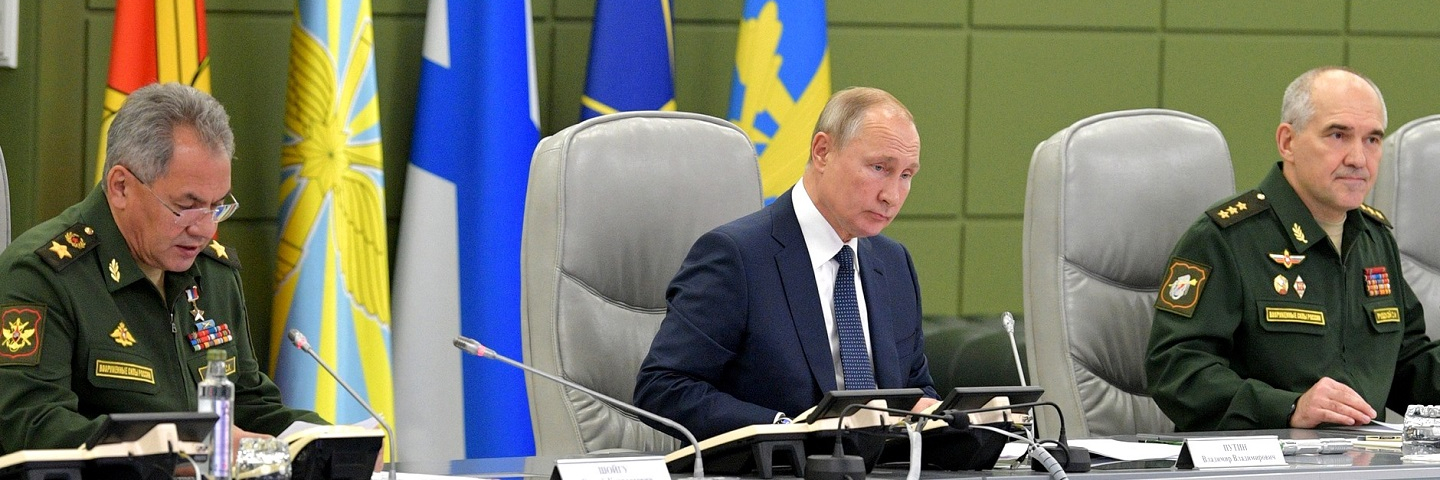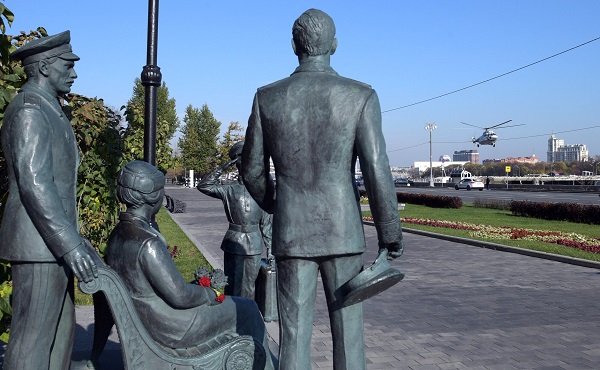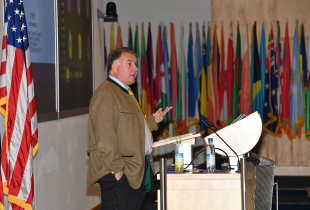
The Grom-2019 Exercise Illuminated the Risks of Nuclear Renaissance in Russian Strategic Culture
Executive Summary
Russian strategic culture has transformed quickly in various and not always coherent directions. One of the increasingly prominent traits is the greater reliance on nuclear capabilities as an instrument of policy. The breakdown of many key elements of the arms control system underpins and intensifies this Russian reenergizing of nuclear deterrence. Russia’s Grom-2019 strategic exercise in October 2019, unprecedented in its scale and complexity, illuminated some alarming features in this nuclear renaissance:
- Russian leadership not only accepts the possibility of but also seeks to prevail in a large-scale nuclear war involving multiple exchanges of various strikes.
- The modernization of Russia’s nuclear arsenal is not yet complete and—because new weapon systems are mixed with old ones—the compatibility of various capabilities is uncertain.
- High-intensity exploitation and exercising of all available assets and testing of new prototypes progressively increases the probability of accidents, which could be blamed on a “hostile external interference.”
- Russian command tends to perceive its readiness to manage the high risks of accidents and brinksmanship as an important strategic advantage over the risk-averse United States and North Atlantic Treaty Organization (NATO).
- The heaviest concentration of nuclear assets and the highest intensity of nuclear-related activities will continue to be found in the Arctic theater.
Introduction
Since Russia’s aggressive activities against Ukraine in spring 2014 and the resulting confrontation with the West, Russian strategic culture has been undergoing a fast and incoherent transformation. A major feature of this transformation is the much-strengthened role of nuclear weapons, underpinned by massive investments in modernizing Russia’s strategic capabilities since the start of the 2010s. Russian President Vladimir Putin’s address to the Federal Assembly in March 2018 further emphasized that the nuclear arsenal is politically instrumental and effectively promoted the breakdown of key elements of the old arms control system.1 That system included the Intermediate Nuclear Forces (INF) Treaty, which in the late 1980s marked the end of the Cold War nuclear deadlock in Europe. Strategic exercise Grom-2019, held on October 15–17, 2019, was supposed to demonstrate the fruitfulness of this nuclear renaissance in Russian strategic thinking and planning.2 Instead, it revealed shortcomings in Russia’s development of its nuclear forces and the growing risks of catastrophic accidents.

Reenergized Nuclear Deterrence
Russian leadership was ready for the dismantlement of the arms control system and actively contributed to this process, but it did not expect the firm U.S. decision to withdraw from the INF Treaty (announced in October 2018 and executed in August 2019).3 Russia’s preferred option was to play it both ways: to manipulate nuclear threats with its new capabilities and to preserve the appearance of commitment to the mostly irrelevant limitations prescribed by several treaties, including the New Strategic Arms Reduction Treaty (START), which was signed in April 2010 and is now destined to expire in February 2021. As that option closed, a new dual-track policy has started to take shape. It aims to prove that Russia is a winner in the post–arms control strategic environment and to push the blame for the breakdown of the old agreements—a development deeply disturbing for many European political elites and public opinion—squarely on the United States. The latter task has targeted the widespread disapproval and even indignation in Europe regarding the policies of the Donald Trump administration in the United States.4 The former task, however, requires a convincing but carefully measured (in order not to provoke an undesirable overreaction) presentation of evidence of Russia’s nuclear superiority in the European theater.
The much-advertised strategic exercise Grom-2019 was supposed to deliver such evidence (although it has been overshadowed in the news by Turkey’s military operation in northern Syria). Involving all elements of the strategic triad and spreading across all strategic directions, Grom-2019 was unprecedented in scale and complexity; Putin personally supervised it, pushing the buttons of the super-computer in the National Defense Control Center.5 The plan for launching simultaneously combined nuclear strikes in different theaters indeed goes far beyond the “escalate-to-deescalate” proposition, which envisages a single or a very limited use of nuclear weapons aimed at altering the pattern of a conventional operation.6 Russian military experts suggested that the scenario of the exercise indicated that Russian leaders prepared for massive nuclear exchanges in a previously unthinkable total war.7 This may appear to be speculation that goes too far, but it reflects the alarming expansion of political discourse on the readiness for and the practicable possibility of a victory in nuclear war.
One unique feature of Grom-2019 was the integrated employment of strategic and nonstrategic capabilities, the latter involving the sea-launched 3M-54 Kalibr cruise missiles and the land-based 9K720 Iskander tactical missiles. Both are relatively new high-precision weapon systems, and the Kalibr missiles were tested from various naval platforms during the military intervention in Syria.8 Combining the strikes by these assets with the use of the elements of the strategic triad makes sense only in complex nuclear exchanges, and indeed the Kalibr and the Iskander missiles are known to be nuclear-capable.
What stands in the way of equipping these weapon systems with nuclear warheads is the Presidential Nuclear Initiative (PNI) advanced by Russian President Mikhail Gorbachev in 1991 and reconfirmed by Russian leaders. According to this initiative (reciprocal to the one made by U.S. President George H. W. Bush), all nonstrategic nuclear warheads are kept in centralized storage.9 To proceed with preparing its nonstrategic capabilities for nuclear use, Russia needs to cancel this initiative, which might happen as a response to the expected expiration of the New START Treaty in early 2021.
Half-Accomplished Nuclear Modernization
The assertive Russian nuclear policy is shaped by a perception that Russia has made great progress in modernizing its strategic assets during a sustained and costly decade-long effort, while the U.S. modernization has been postponed. In reality, the material foundation of the reenergized deterrence is not as solid as the Russian leadership declares and believes. Many replacement programs are still in progress, and many others have barely started, so President Putin’s assertions regarding the “peak of acquisitions” that was allegedly passed in 2015–2017 are dubious at best.10 In reality, less than half of most major programs, particularly strategic ones, have been modernized. The introduction of weapon systems based on new technologies and the continuing reliance on Soviet-era hardware have made the structure of strategic forces quite unbalanced and have increased functional incompatibility among various elements.
For instance, one successful program is the replacement of the solid-fuel road-mobile Topol (SS-25) intercontinental missile with the Topol-M (SS-27) and Yars (SS-29) missiles; however, the heavy liquid-fuel Sarmat (SS-X-30) missile, which was advertised by Putin in the 2018 speech as ready for deployment, has not even started initial tests.11 The program for constructing Voronezh-M/VP/SM early-warning radars is progressing smoothly, but the plan for deploying a new generation of early-warning satellites has been derailed by the multiple setbacks and failed launches in the Russian space program. The prioritization of the program for deploying the Borei-class (Project 955A) strategic submarines (three are operational, one is in sea trials, and four are under construction) has caused massive delays in the program for Yasen-class (Project 885M) nuclear attack submarines.12 In addition, the development of a new PAK DA strategic bomber has been postponed indefinitely. The envisaged resumption of serial production of the Tu-160 bombers at the Kazan plant is a tall order, so the necessary modernization of the long-range aviation has not even started in a meaningful way.13
Contrary to Putin’s claims, progress in the execution of key projects in modernizing the strategic arsenal demands that more resources and money be allocated in the next five years than in the previous cycle.14 Had the Russian economy performed as it did in the early years of Putin’s leadership, such expenditures would have been acceptable; in the protracted stagnation, however, they become prohibitively heavy. The irreducible desire in the Kremlin and among the top brass to deliver both symmetric and asymmetric answers to each and every U.S. and NATO move in strengthening their nuclear deterrence posture determines the need to economize on nonessential costs, such as maintenance, repairs, and personnel, which inevitably increases the probability of breakdowns and accidents.
Repercussions and Risks
Increasingly heavy exploitation of half-modernized nuclear assets results in their rising propensity to malfunction. A remarkable sequence of nuclear-related accidents occurred in 2019. On January 22, a Tu-22M3 Backfire bomber crash-landed in the Olenegorsk, Murmansk Oblast, region, with three casualties.15 On July 1, a fire broke out on board the nuclear deep-dive submarine AS-31 (Project 10831), with 14 fatalities and a meltdown of the reactor narrowly averted.16 On August 9, a prototype 9M730 Burevestnik nuclear-propelled missile exploded after a failed test in the White Sea, costing five scientists their lives and causing no small panic among the inhabitants of Severodvinsk.17 On October 17, during the Grom-2019 exercise, the Delta III–class strategic submarine Ryazan of the Pacific fleet launched one R-29R missile but failed to launch another and had to abort the mission.18 On October 24, a conscript soldier serving in a unit guarding a storage of nuclear munitions opened fire and killed eight servicemen.19 These setbacks involved some old weapon systems (the Tu-22MS bomber and the Ryazan submarine) and some newly designed systems (the Burevestnik missile) and invariably featured human errors and breaches of service rules.
Russian command shows little inclination to draw conclusions from these accidents and typically seeks to cover up the details—and to shift the attention from setbacks to some new achievements, such as the launch of a Bulava missile from the newly built Borei A–class Knyaz Vladimir submarine.20 The top leaders tend to perceive and play up their readiness to manage far higher risks than the risk-averse NATO adversaries as an important strategic advantage. It is very probable that the blame for a next bad accident, whether of a kinetic or a cyber-nature, might be pushed on a so-called hostile external interference.
The logical next step in this active wielding of nuclear instruments is to bring the warheads closer to the nonstrategic delivery systems and to organize training for their practical use. This can be done only after the PNI is canceled, which requires nothing more than a presidential decree. Lifting this self-imposed restriction would make it possible to return nuclear torpedoes to attack submarines on patrol and to store nuclear munitions (including for the Iskander missiles) in such strategically important areas as Kaliningrad and Crimea.
One serious problem with this renuclearization of nonstrategic forces is the unreliability of nuclear warheads; neither computer simulations nor subcritical experiments could remedy this issue.21 Withdrawal from the Comprehensive Nuclear Test Ban Treaty, ratified by the Russian Federation Council on June 30, 2000, is a more serious affair than the annulment of the PNI would be, but the political elite in Moscow will definitely close ranks behind the Kremlin if it decides to resume testing. The Novaya Zemlya test site is conveniently located far away from even small settlements and has been modernized for various military purposes.22 Breaking the global taboo on nuclear explosions is certain to deliver a major blow to the nonproliferation regime, but Russian leaders may conclude that the appearance of several new nuclear-armed states would make its preponderant nuclear arsenal more useful in establishing a new multilateral balance of threats.
Conclusion
Nuclear deterrence has always remained an integral but rather isolated element of Russian strategic culture; presently, however, nuclear deterrence has not only has risen in importance but also interplays with other fast-evolving traits and features. Massive investments in modernizing Russia’s nuclear arsenal need to be sustained during this period of protracted economic stagnation; this imperative strengthens the political desire to harvest dividends from the continuing investments of resources and efforts. Moscow needs to make nuclear weapons more useful instruments of policy and bring into the strategic calculus some advantages it has gained, such as the nonstrategic delivery systems and warheads. The unprecedented scale and complexity of the Grom-2019 strategic exercise in October 2019 was supposed to demonstrate these advantages and test the readiness of formerly strictly conventional parts of the armed forces to support and interact with the strategic triad.
Grom-2019 has also illuminated some alarming developments in the Russian nuclear posture. It added to the chain of nuclear-related accidents and confirmed that the Russian top brass not only is ready to take on and manage far higher risks than what is deemed acceptable by the United States and NATO, but also perceives this readiness as a key strategic advantage. The exercise also indicated that further interoperability between strategic and nonstrategic capabilities requires that they take the easy but consequential political step of canceling the PNI, which would make it possible to bring nuclear munitions closer to the new delivery systems, such as the Iskander land-based tactical missiles and the Kalibr sea-based cruise missiles. Although Grom-2019 was designed to cover all strategic directions, it has also shown that most important nuclear activities and assets (as well as most of the accidents) will continue to be concentrated in the Arctic theater. Ultimately, Russian strategic culture is set to exploit the breakdown of the arms control system to Russia’s advantage.
For Academic Citation
Pavel K. Baev, “The Grom-2019 Exercise Illuminated the Risks of Nuclear Renaissance in Russian Strategic Culture,” Marshall Center Security Insight, no. 43, January 2020,
https://www.marshallcenter.org/en/publications/security-insights/grom-2019.
Notes
1 On the content and the impact of that address, see Pavel K. Baev, “Russian Nuclear Modernization and Putin’s Wonder-Missiles: Real Issue and False Posturing,” Russie.Nei.Visions, No. 115, Institut Français des Relations Internationals, August 2019, https://www.ifri.org/en/publications/notes-de-lifri/russieneivisions/russian-nuclear-modernization-and-putins-wonder.
2 The unique character of this exercise is examined in Roger McDermott, “Grom-2019 Tests Russia’s Nuclear Deterrent,” Eurasia Daily Monitor, Vol. 16, No. 147, October 23, 2019, https://jamestown.org/program/grom-2019-tests-russias-nuclear-deterrent.
3 One sound Russian perspective is Alexander Savelyev, “Russia-US: On the Brink of a New Nuclear Arms Race,” Russian International Affairs Council, August 14, 2019, https://russiancouncil.ru/en/analytics-and-comments/analytics/russia-us-on-the-brink-of-a-new-nuclear-arms-race.
4 On the problems inherent to this disapproval, see Andrew A. Michta, “Without the US, European Defense Will Fall to Pieces,” The American Interest, October 23, 2019, https://www.the-american-interest.com/2019/10/23/without-the-us-european-defense-will-fall-to-pieces.
5 “Nuclear Deterrence Ready: Putin Presides over Mega Missile Exercise Involving Submarines, Bombers, & Ground Launchers,” RT, October 17, 2019, https://www.rt.com/russia/471143-mega-missile-exercise-russia.
6 This proposition is mentioned in the Global Trends report from the U.S. Office of the Director of National Intelligence. See the “How People Fight” section in U.S. Office of the Director of National Intelligence, “Annex: Key Global Trends,” in Global Trends: Paradox of Progress, Washington, D.C., 2017, https://www.dni.gov/index.php/key-global-trends/how-people-fight. On the shortcomings of this proposition, see Jay Ross, “Time to Terminate Escalate to De-Escalate—It’s Escalation Control,” War on the Rocks, April 24, 2018, https://warontherocks.com/2018/04/time-to-terminate-escalate-to-de-escalateits-escalation-control.
7 See Aleksandr Golts, “Rehearsal of a Catastrophe,” Ezhednevny zhurnal (in Russian), October 17, 2019, http://ej.ru/?a=note&id=34300.
8 The impact of this modernization is usefully examined in Nikolai Sokov, “Russia’s New Conventional Capability: Implications for Eurasia and Beyond,” PONARS Eurasia, Policy Memo 472, May 2017, http://www.ponarseurasia.org/memo/russias-new-conventional-capability-implications-eurasia-and-beyond.
9For an in-depth assessment of this arrangement, see Pavel Podvig and Javier Serrat, Lock Them Up: Zero-Deployed Non-Strategic Nuclear Weapons in Europe, Geneva: United Nations Institute for Disarmament Research, March 29, 2017, https://unidir.org/publication/lock-them-zero-deployed-non-strategic-nuclear-weapons-europe.
10 Some reduction of the Russian military budget in 2017–2018 resulted in the accumulation of debts; see Ivan Safronov, “Putin Demanded Again to Solve the Debt Problem in the Defense Industry,” Vedomosti (in Russian), October 16, 2019, https://www.vedomosti.ru/politics/articles/2019/10/16/813934-putin-vnov-potreboval-problemu-dolgov.
11 See Ivan Safronov and Aleksei Nikolsky, “Tests of Newest Russian Nuclear Missile Will Start Early Next Year,” Vedomosti (in Russian), October 29, 2019, https://www.vedomosti.ru/politics/articles/2019/10/29/815013-letnie-ispitaniya-sarmat.
12 For a perhaps slightly exaggerated evaluation, see Mark Episkopos, “Is Russia’s New Stealth Submarine Project Doomed?” National Interest, August 7, 2019, https://nationalinterest.org/blog/buzz/russias-new-stealth-submarine-project-doomed-71856.
13 While visiting the Kazan plant in May 2019, Putin tried to project the impression that the modernization was perfectly on track; see Ivan Safronov and Aleksandra Dzhordzhevich, “The Choice of Real ‘Strategists,’” Kommersant (in Russian), May 14, 2019, https://www.kommersant.ru/doc/3967519.
14 The most accurate evaluation of these costs can be found in Julian Cooper, “The Funding of Nuclear Weapons in the Russian Federation,” Oxford, United Kingdom: Changing Character of War Centre, Pembroke College, October 2018, https://static1.squarespace.com/static/55faab67e4b0914105347194/t/5bb1ea3ee4966b5320fa197c/1538386496442/The funding of nuclear weapons in the Russian Federation.pdf.
15 Andrew Osborn, “Nuclear-Capable Russian Bomber Crashes amid Snowstorm,” Reuters, January 22, 2019, https://www.reuters.com/article/us-russia-military-airplane-crash/nuclear-capable-russian-bomber-crashes-amid-snowstorm-defence-ministry-idUSKCN1PG23L.
16 H. I. Sutton, “New Details on the Tragedy of the Russian Spy Submarine Losharik,” Forbes, October 8, 2019, https://www.forbes.com/sites/hisutton/2019/10/08/new-intelligence-on-russian-losharik-nuclear-submarine-accident/?sh=3bb16ad259e9.
17 John Krzyzaniak, “The Nenoksa Accident: A Timeline of Confusing and Conflicting Reports,” Bulletin of the Atomic Scientists, August 23, 2019, https://thebulletin.org/2019/08/the-nenoksa-accident-a-timeline-of-confusing-and-conflicting-reports.
18 Ivan Safronov, “Submariners Performed a Curtailed Program,” Vedomosti (in Russian), October 21, 2019, https://www.vedomosti.ru/politics/articles/2019/10/20/814167-podvodniki-otstrelyalis.
19 Vladislav Trifonov et.al, “Soldier Massacred Guar Post,” Kommersant (in Russian), October 25, 2019, https://www.kommersant.ru/doc/4140076.
20 Thomas Nilsen, “Bulava Ballistic Missile Launch from Brand New Strategic Sub in the White Sea,” Barents Observer, October 30, 2019, https://thebarentsobserver.com/en/security/2019/10/bulava-ballistic-missile-launch-brand-new-strategic-sub-white-sea.
21 On probable Russian subcritical tests, see Mark B. Schneider, “Yes, the Russian Are Testing Nuclear Weapons, and It Is Very Important,” RealClearDefense, August 8, 2019, https://www.realcleardefense.com/articles/2019/08/08/yes the russians are testing nuclear weapons and it is very important 114651.html.
22 Remarkable in this regard is the claim by the military authorities that Novaya Zemlya has completely recovered from the huge atmospheric nuclear tests in the 1950s–1960s; see “The Northern Fleet informed That Novaya Zemlya Has Recovered After the Soviet-Era Nuclear Tests,” TASS (in Russian), November 23, 2018.
About the Author
Pavel K. Baev is a Research Professor at the Peace Research Institute Oslo (PRIO). Pavel specializes in Russian military reform, Russian conflict management in the Caucasus and Central Asia, energy interests in Russia’s foreign policy, and Russian relations with Europe and NATO.
Russia Strategic Initiative (RSI)
This program of research, led by the GCMC and funded by RSI (U.S. Department of Defense effort to enhance understanding of the Russian way of war in order to inform strategy and planning), employs in-depth case studies to better understand Russian strategic behavior in order to mitigate miscalculation in relations.
The Marshall Center Security Insights
The George C. Marshall European Center for Security Studies in Garmisch-Partenkirchen, Germany, a German-American partnership, is committed to creating and enhancing worldwide networks to address global and regional security challenges. The Marshall Center offers fifteen resident programs designed to promote peaceful, whole of government approaches to address today’s most pressing security challenges. Since its creation in 1992, the Marshall Center’s alumni network has grown to include over 13,985 professionals from 157 countries. More information on the Marshall Center can be found online at www.marshallcenter.org.
The articles in the Security Insights series reflect the views of the authors and are not necessarily the official policy of the United States, Germany, or any other governments.

